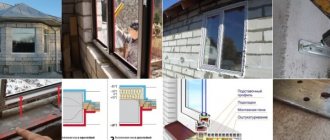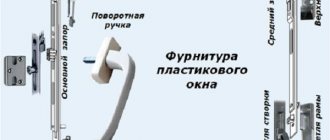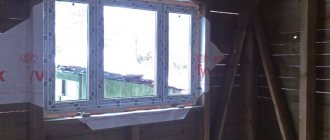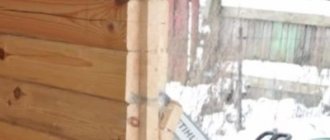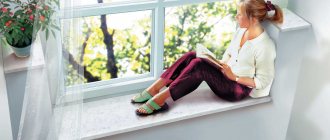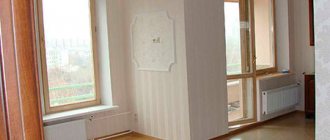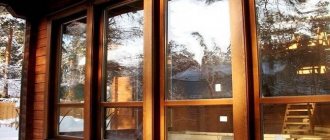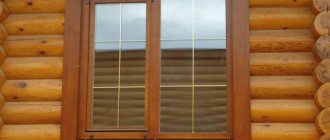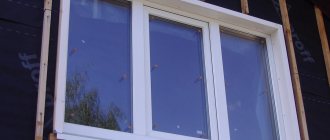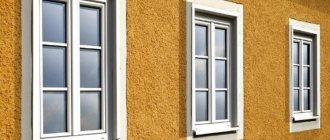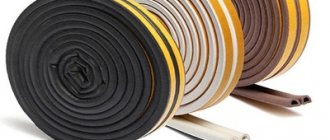When it comes to installing windows in a house made of cellular blocks, two different approaches to fastening technology collide.
Proponents of polyurethane foam claim that this material is so reliable and airtight that it does not require the use of fittings. Fans of dowels, on the contrary, rely on mechanical contact between metal and blocks.
The truth, as often happens, lies in the middle of polar opinions.
Therefore, we decided to consider in detail the features of high-quality installation of windows in aerated concrete and foam concrete walls.
What is the installation depth
When determining the installation depth of windows in the opening, that is, the distance from the outer surface of the wall, you need to take into account several features:
- presence of façade cladding;
- the need for insulation;
- width of tides;
- desired width of window sills.
If the facades of the house will be covered with any decorative material without insulation, the windows can be installed directly along the line of the outer surface of the facade. Shifting them inward may only be necessary due to the design features of fastening the cladding.
If it is necessary to insulate facades (when this is required in accordance with the climatic conditions of the area), window blocks must be installed inside the opening at some distance from the outer surface. This is due to the fact that high-quality insulation of aerated concrete at the junction of the window will be structurally difficult to perform if the window is installed along the line of the wall. The aerated block wall around the perimeter of the window may freeze, since its calculated thickness will not exceed the thickness of the frame. Usually this is no more than 120 mm.
When is it better to install plastic windows?
There is no consensus on this issue. Beginner developers ask when they can install windows in a house made of aerated concrete or foam block. They are given advice that is more ridiculous than the other. Some argue that cellular blocks have a very large shrinkage and windows can only be installed a year after the construction of the box.
Others try to provide a “scientific” basis for this statement and argue from three types of shrinkage of gas silicate and foam block. At the same time, all advisors unanimously ignore the manufacturers’ data. They clearly state that the natural shrinkage of cellular blocks does not exceed 0.3 mm per 1 meter of wall height. Therefore, there is no need to talk about its critical impact on window frames. Confusion arises due to the substitution of the concepts of shrinkage of lightweight concrete and building settlement.
Deformation settlement of a structure (walls and foundation) does not occur due to the evaporation of moisture from concrete and blocks. It is caused by uneven subsidence and rise of soil under the influence of freezing and thawing water in it. It is from such shrinkage that load-bearing structures need to be protected. For the foundation, frames made of reinforcement are used, and for walls made of aerated concrete and foam blocks, reinforced concrete belts are used, which are poured at the level of the interfloor ceilings. If these measures are not taken, then cracks in the walls and foundation during construction on weak and water-saturated soils are guaranteed.
What practical conclusions can be drawn from our theoretical reasoning?
Installing windows in an aerated concrete house
When choosing to install plastic windows in a foam block, you should know:
- This can be done three months after the walls are built. This time interval is necessary for the openings to shrink and acquire their true size.
- The laying and pouring of the foundation must be of high quality to prevent soil movement.
- Technologies for fastening plastic structures must be selected depending on the individual design features, the size of window openings, and climatic conditions.
The installation of windows in an aerated concrete house will be of high quality if:
- ensure tightness of seams;
- protect joints from differences in external and internal temperatures, controlling heat loss;
- eliminate the possibility of mechanical breakdowns, damage to adjacent walls, their cladding and window elements.
How to ensure the tightness of installing windows in an aerated concrete house?
The structure of the block has a peculiarity: it has cut out protrusions. Their presence when applying sealant, polyurethane foam or tape ensures deep penetration of the connecting substance into the foam block wall. During its expansion stage, construction foam fills existing voids, guaranteeing optimal window tightness. Mechanical strength is achieved using specially selected plates and dowels.
How to fix the frame in the opening
Installation of windows in aerated concrete can be done using the following methods:
Having removed the double-glazed window, a hole is drilled in the window opening, the depth being equal to the size of the dowel. It is this that is the main fastening element. At the end of this action the glazing is returned.
You can make the fastening without removing the glass unit. In this case, you need to insert anchor plates, which are fastened with self-tapping screws. In this case, you need to fix the window in aerated concrete with nails. Many people consider this method dusty and labor-intensive. In addition, it requires additional work to mask visible fastening elements. Installing a PVC profile into an aerated concrete block in this way means being inferior in strength to the method using polyurethane foam. In addition, after final fixation, the position of the window will not be subject to correction. Therefore, it is immediately necessary to ensure that the fasteners fit accurately.
When choosing a method using polyurethane foam, it would be correct to first place the profile on special plates. This will give you the opportunity to change position if necessary.
Basic moments
It should be noted that indicators of high-quality installation of PVC windows in a private house are: ensuring tightness of joints between the frame and the wall and from the blocks, long service life, absence of heat loss, ideal alignment of the frame, high-quality installation of ebb and window sills.
READ ON THE TOPIC: How to properly install a plastic window sill and make slopes on the windows
For more hermetically sealed joints, special protrusions-quarters are cut out in the blocks (during the process of laying the blocks, it is possible to provide and cut quarters in advance); special sealants and PSULs are also used. The insulation is polyurethane foam; it is used to fix the area of direct contact between the wall and the frame. Mechanical strength is achieved by fastening the frame with dowels or mounting plates.
The installation depth (from the frame to the edge of the opening) can vary between 8-12 cm depending on the thickness of the block wall. If the masonry is additionally insulated, then the window is mounted closer to the outer edge of the wall so that the dew point is outside the window frame. This will protect the glass unit from condensation and freezing.
Installing the window sill and ebb, sealing the frame
We found out how to attach plastic windows to aerated concrete. Now let's look at the remaining activities.
For sealing gap areas, there is nothing better than simple foam for installation work. But there is one feature - you should not just fill all the voids with foam and remove its excess after hardening. There is one more mandatory condition - the foam needs protection from natural factors.
Instructions for installing the window sill, ebb and flow and sealing the frame are as follows:
the surface of the slopes of the aerated concrete window opening is slightly moistened, for which you can use a simple spray bottle;
- It is necessary to foam not only vertically located seams, but also the entire space of the external and internal sides of the installed profile. This measure is necessary for installing ebb and window sill boards;
- after the foam has completely dried, its excess is removed, while the window sill can be created with a slight slope, if necessary;
- from inside the room, a water vapor barrier tape is glued to the foam layer, which will reliably protect against moisture;
- When installing the flashing, first a waterproofing film material is glued onto the foam layer, bringing its edge one to two centimeters onto the wall surface. After this, the ebb is installed in the groove of the stand profile and fixed with self-tapping screws;
- The window sill is attached using the same principle.
At the end of all work, it is necessary to remove the protective film from the frame. Its main purpose is to protect the plastic from accidental scratches during transportation and installation. During operation of the window unit, the film does not carry any meaning. If this is not done in a timely manner, after a certain period of time the film will stick tightly to the frame; it will have to be preheated or wet before it can be removed.
Preparatory work
Before you begin to describe this stage, you need to at least superficially familiarize yourself with the material that you have to work with.
Aerated concrete is an environmentally friendly material that is popular due to its strength and ease of construction processing. Therefore, to cut aerated concrete blocks, use the most common hacksaw with fine teeth. And in order to drill holes in this building material, it will be enough to use a well-sharpened drill for wood or metal. Advice!
To make the process of preparing for window installation as fast and comfortable as possible, use the following tools and materials: tape measure, hammer drill, nail puller, steel sheet and plastic film.
First, the room where installation work will be carried out is cleaned. That is, it is necessary to completely free the space from furniture, carpets and other objects. Since installing a window is a very dusty job. If possible, cover the floor with plastic film - this will simplify the process of cleaning the room in the future. If at the time of starting installation of a new window there is an outdated structure in the opening, then it can be dismantled using a hammer and chisel. This will be much more difficult and longer than using a rotary hammer with a fixed bit, which will take no more than 10 minutes.
If the window installation will be carried out on a floor above the first, then it is worth adhering to certain safety measures. After all, there may be an external air conditioner unit under the window or, worse, people passing by. If these situations are not excluded, then at the edge of the future slope it will be necessary to secure a steel sheet along the entire width. No equipment or fasteners are required to install it. It will be enough to squeeze the sheet between the walls until it is absolutely immobile.
In parallel with the window, it is necessary to dismantle the ebb. This can be done using a regular nail puller or pliers. The most difficult and time-consuming stage can be called dismantling the old window sill. Of course, if it is made of wood, then there should be no problems. But sometimes the window sill can be concrete. To remove the window sill you need to use a hammer drill. First we make the basic groove and start swinging. We rock the wooden structure and carefully pull it out, but with the concrete one you need to be extremely careful. After all, such a window sill weighs quite a lot and during the finishing dash it is better to hold it on the opposite side and keep your feet at a safe distance. After dismantling, all dirt and dust from the window opening must be swept out with a broom or brush.
How to choose a cutting method?
The cutting method is selected depending on whether the wall is monolithic, made of slabs or panels:
- In order to make a window or doorway in a concrete wall or expand an existing one, diamond cutting devices are used, which are fixed in different types of equipment.
- The walls of the building are made of monolithic concrete and are supported by reinforced concrete, so the load on them is minimal. You can make a new opening for a door or window using diamond tools.
- If the house is panel, then a very large load is placed on the walls of the lower floors, so additional openings in such houses are allowed only on the upper floors. For cutting, equipment that operates without vibration is used, with diamond blades, saws and drills.
Reinforcement technology
How to properly reinforce aerated concrete depends on the type of reinforcement used. It is laid either in the thickness of the mortar joints, or concrete mini-belts are installed parallel to them in grooves with a cross-section of 2.5 * 2.5 cm. The second method is more often used, which can be considered classic, so we will mainly talk about it.
You can cut grooves in different ways:
- Manual wall chaser. There is almost no dust, but it is quite labor-intensive.
- Angle grinder (grinder). Quite quick and easy, but a cloud of dust rises.
- Electric wall chaser. It is easy to work, cutting grooves is done quickly and practically without dust, but such equipment is expensive if you purchase it only for one-time use.
Reinforcement of the first row
On walls less than 200 mm thick, the reinforcement is laid in one row, on thicker walls - in two rows. The reinforcement is placed either in the center of the masonry, or, if there are two rows, at a distance of 60 mm from the edges of the blocks.
After cutting the grooves, it is necessary to remove dust from it, after which the grooves are moistened and half filled with solution. The reinforcement is recessed into it, then they begin to apply a mortar bed for the blocks. On blind sections of walls, the row of reinforcement is continuous - if the length of the rods is not enough, they are connected with an overlap of at least 60 cm.
Reinforcement of window openings
In walls with openings, reinforcement under and above them is carried out regardless of the order of the row, and only in certain areas: along the lower border of the opening and above it. The depth of installation of reinforcement beyond the boundaries of the opening can be calculated by dividing the width of the opening by 3 - for example, 250/3 = 84 cm on each side.
Some European manufacturers (for example H+H) recommend installing fittings everywhere at least 90 cm from the boundaries of the opening. In the same way, different sources voice unequal amounts of insertion of reinforcement into the masonry in the places where the lintels support - some have a minimum of 20 cm, others 25. But the main thing is that the ends of such rods, since they are not united by a common strapping contour, are bent at right angles and included in fines of the appropriate form. Similarly, reinforcement is laid above the opening that is closed without a lintel.
Vertical wall reinforcement
Domestic standards do not say anything about vertical reinforcement, but European standards provide for this option without fail. This is a device of vertical belts that should connect the upper monolithic belt with the foundation. At a minimum, such reinforcement is provided in the corners of buildings and at the junction of internal walls.
Unlike horizontal reinforcement, such reinforcement can increase the load-bearing capacity of aerated block walls in situations where:
- the house is being built on a slope;
- there is a danger of avalanches;
- significant impact of lateral loads (wind);
- aerated concrete of low density and low strength is used;
- it is necessary to strengthen the places where heavy elements support;
- it is necessary to strengthen the too small partitions between the windows;
- columns are reinforced.
It is most convenient to carry out vertical reinforcement using perforated blocks (O-blocks), designed to form ventilation ducts. They are laid one above the other, rod reinforcement is installed in the channel with anchoring in the foundation (for which, when pouring it, mortgages are installed), and sealed with concrete.
If such blocks are not at hand, a vertical groove is cut from the inside of the masonry, into which one rod with a diameter of 14 mm is placed. Then the open part of the hole is covered with a board as formwork, after which it is filled with B15 concrete. Vertical reinforcement can be either one floor high or pass through all floors.
For the reinforcement to work effectively, it must be anchored in horizontal monolithic belts. To do this, when pouring the foundation, in the places where the vertical reinforcement passes, L-shaped rods with a branch of 20 cm are laid, buried into the monolith by at least 15 cm.
Vertical rods are then welded to them and placed in the grooves. The overlap during welding is made at least 40 times the diameter of the reinforcement (but not less than 610 mm). Long extensions of reinforcement are left on top, which are also bent and welded to the frame and embedded in a horizontal belt under the ceiling.
What is needed for construction?
For high-quality masonry, you need to have not only good skills and abilities, but also good consumables and tools. They can make a mason's job much easier.
Materials for masonry:
- gas blocks of the required thickness, strength and density;
- cement-sand mortar (cement, sand, water, plasticizers, additives);
- adhesive mixture - a special glue that reduces the thickness of the layer between the elements and makes the connection between them stronger;
- reinforcement or reinforcing mesh - to strengthen the wall and increase its strength.
Tools for work:
- A hacksaw or saw with hard teeth - for cutting blocks and giving them the required or non-standard sizes. You can use a wood saw to cut products. Although the quality of the cutting will not be very even, this will not affect the performance of the material and its durability.
- Mallet or rubber hammer - designed for leveling elements and fitting them along one straight line.
- Drill or mixer with an attachment - for mixing cement-sand mortar or mixing the adhesive mixture with water.
- Notched trowel and ladle - for applying the solution to the products and leveling the mixture over the surface of the blocks.
- Grater – for combing out protrusions and bumps on individual elements in order to perfectly fit the products.
- Wall chaser - for cutting special holes or grooves in elements for laying reinforcing bars.
- Building levels - for aligning elements vertically and horizontally. You can use both regular and water levels.
- Tape measure and pencil - for marking blocks with their subsequent trimming.
Tips and tricks
It is important to remember that if the length of the opening does not exceed 1.2 meters, and the height is less than two-thirds of the width, then the most convenient option for the device will be a lintel made of standard blocks without the use of additional fasteners. Blocks must be laid using removable temporary formwork and special glue for cellular aerated concrete
In this case, the side elements are recessed into the wall by at least 115 mm.
Additional reinforcement can be the reinforcement of the rows located above the opening. The optimal cross-section of the reinforcement used is approximately 6-8 mm. The end part extends beyond the boundaries of the opening by 0.5 m on both sides of the masonry. The ends need to be given an L-shape and anchored into the masonry of aerated concrete blocks.
Factory solutions
The technology for using lintels in private housing construction has several fundamental differences from the installation adopted in modern and mass construction using cellular aerated concrete. Currently, several types of jumpers are used, which differ in design features and rules of application .
Ready-made version of reinforced gas silicate lintel according to GOST
Ready-made factory aerated silicate (aerated concrete) lintels are ordinary aerated concrete beams with a rectangular cross-section and an internal frame in the form of reinforcement coated with a special anti-corrosion compound.
Arrows on the element indicate the correct direction of installation.
The main advantages are:
- properly reinforced aerated concrete does not crack , does not “float” and does not collapse during long-term use;
- aerated concrete lintels are high-strength, lightweight structures that do not place additional load on the constructed walls and foundation;
- the cellular structure of the aerated concrete lintel is identical to the structure of the building blocks, therefore it does not cause a decrease in thermal efficiency , and as a result there is no need for additional insulation.
Main dimensions of gas silicate jumpers:
- Height - 124 mm;
- Width - 115 mm, 150 mm, 175 mm;
- Length - 1300-3000 mm.
Check on the manufacturers website.
U-block construction
The most popular option is to install precast lintels over windows in walls made of cellular aerated concrete with permanent formwork based on U-shaped elements.
The article provided by the link provides information about the manufactured sizes of these elements and the method of self-production.
Reinforced concrete lintels
These factory products are concrete beams with reinforcement inside.
In terms of thermal conductivity, concrete is noticeably inferior to gas silicate.
If you plan to insulate the walls of the house with mineral wool, then these beams can be used.
But for walls without insulation, reinforced concrete will act as a cold bridge.
In this case, the aerated concrete lintels proposed in the first option look better.
Jumper prices
The cost of aerated concrete, reinforced lintels depends on their size and manufacturer. They are manufactured by factories specializing in the production of aerated concrete blocks.
As an example, here is the price list of one of the leading Russian manufacturers represented on the markets of Moscow and the Moscow region:
| Length x width, mm. | Wholesale price, rub./1 pc. | Retail from the factory, rub./1 pc. |
| 1 200 x 100 | 435 | 465 |
| 1,500 x 100 | 541 | 571 |
| 1 200 x 150 | 648 | 694 |
| 2,000 x 100 | 710 | 765 |
| 1,500 x 100 | 801 | 856 |
| 1 200 x 200 | 854 | 915 |
| 2,000 x 150 | 1 066 | 1 145 |
| 1,500 x 200 | 1 069 | 1 148 |
| 2 500 x 150 | 1 432 | 1 498 |
| 2,000 x 200 | 1 425 | 1 501 |
| 3,000 x 150 | 1 602 | 1 720 |
| 1,500 x 300 | 1 602 | 1 720 |
| 3,000 x 200 | 2 135 | 2 298 |
| 2,000 x 300 | 2 125 | 2 289 |
| 2 500 x 300 | 2 658 | 2 852 |
| 3,000 x 300 | 3 189 | 3 422 |
Reinforced beams are an integral element in the construction technology of cellular concrete. Designed to distribute the load from the rows located above, armored belts and other elements pressing on the base. The absence of cracks in the walls is guaranteed only if technological features and building codes are observed during their installation.
Possible difficulties and errors
Errors or difficulties in construction may arise in the following cases:
Purchase of low-quality materials (blocks, glue, foam, fittings)
It is necessary to pay attention to certified material and guarantees from trusted manufacturers. Here, saving and purchasing fakes is not appropriate.
Errors in designs and calculations, especially in load distribution
Cracks may appear, which will then need to be eliminated with the help of additional investments and the expenditure of your own time. To create a project and the correct drawings, it is better to contact specialists.
Refusal of reinforcement. Supporting the gable wall with steel rods will strengthen the wall many times over and distribute the load evenly. So the structure with reinforcement will last for many years and will never collapse.
Failure to comply with technological standards that relate to the selection of consumables, installation of walls and the sequence of construction stages. To prevent this from happening, it is necessary to comply with the requirements of a number of GOSTs regarding the quality of gas blocks and construction with them: GOST R 57334-2016/EN 771-4:2011;
SP 339.1325800.2017;
STO 501-52-01-2007.
Failure to comply with the temperature conditions for masonry and work. Most experts believe that it is more advisable to carry out construction work in dry weather, with atmospheric temperatures starting from +5 °C.
Firstly, the color of the material matters. It should not be yellowish - only light gray.
Yellowness indicates that the material was manufactured with violations, and its composition contains a huge amount of sand, which is unacceptable for the composition according to GOST, and indicates a fake, and not high-quality work from the manufacturer.
The appearance of the gas block is also of great importance. If it has large cells, then it has low density, and for fronts D should be as dense as possible. The higher the indicators, the stronger and more durable the wall will be - this is the main requirement for the structural type of cellular material.
Which is better - single-chamber or double-chamber?
When choosing modern plastic windows, people often have a question about which double-glazed window is better to choose.
A double-glazed window is a product that consists of a certain number of glasses.
A sealed chamber is formed between the glasses, which is mainly filled with sealed gas. A special aluminum profile is used to connect the glass.
Among all the possible options, people often think about single-chamber and double-glazed windows. What interests them most is the difference between products and which one is more effective and acceptable for a particular region.
Advantages and disadvantages of single-chamber double-glazed windows
This double-glazed window is a structure that consists of two glasses. They are separated from each other by an aluminum frame.
The space between the glasses is sealed and filled with absorbent. Such designs have certain advantages and disadvantages.
As for the advantages, they include:
- light weight of the structure, which reduces the load on the fittings. As a result, the service life of the window is significantly increased;
- possibility of using energy-saving glass. The design with such glass has high thermal insulation properties, no worse than that of a two-chamber package; windows with such a package let in a significant amount of light;
- low cost.
Unfortunately, such designs also have some disadvantages. Among them are:
- condensation formation at a temperature of 8 degrees;
- low noise insulation properties.
But, despite the presence of shortcomings, windows with single-chamber double-glazed windows are especially popular among the population. They are often used for glazing loggias and balconies.
Advantages and disadvantages of two-chamber structures
As for the two-chamber ones, they consist of three glasses, which are separated by an aluminum profile. In such double-glazed windows, two chambers are created, which are filled with inert gas.
The advantages of double-glazed windows include:
- high resistance to heat transfer. Condensation on glass forms at very low temperatures, which are 30 degrees below zero;
- good sound insulation properties.
As for the disadvantages of such structures, experts highlight:
- heavy weight, which significantly makes the window unit heavier;
- significantly low light transmittance. If single-chamber windows transmit 80% of light, then double-chamber windows - 74%;
- high price.
Often, plastic windows with double-glazed windows are used for glazing residential premises. They allow you to reduce heat loss and maintain the temperature in the room for a long time.
Regulatory requirements for the installation of window openings
The requirements for making openings in brick houses for wooden or metal-plastic double-glazed windows are, in principle, the same. Creation begins with the completion of a house project. It should indicate the location of window portals, their dimensions and the technology for laying brick rows.
Basic requirements when making window openings in a brick household:
- Height from the floor: living rooms from 0.700 to 0.900 m; kitchen from 0.800 to 1.200 m; bath, toilet, outbuildings up to 1,600 m; warm veranda and balcony from 0.700 to 1.000 m.
- Underneath it is a base of 10 rows of ordinary brickwork. The final plane is made of blocks laid perpendicular to the wall axis, protruding outward.
- The width of the portal is wider than the dimensions of the frame.
- The window unit is installed from inside the room.
- The frame must rest against the slope with its front part.
- After laying the side walls of the opening, a ceiling is laid on top of them, taking on the entire load of the upper brick rows and ceiling beams.
- A concrete beam from 250 to 300 mm or a metal profile 120x120 mm is used as a lintel.
- Before facing walls with an installed frame, reinforcement mesh is used along the edge of the portal.
Advantages
Advantages of plastic window structures:
- Excellent heat and sound insulation.
- Protecting the room from sunlight in the summer.
- Energy saving properties.
- Tightness.
- Easy to install and maintain.
- Reliable protection of the room from moisture, dust and wind.
- Affordable price.
- Aesthetic appeal.
- Frost resistance.
- Safety for the environment and human health.
- Wide selection of shapes and sizes.
However, most manufacturers are constantly improving their products, trying to correct all the shortcomings that exist in them.
After weighing all the pros and cons, we can come to the conclusion that plastic window structures are an excellent option for apartments and private houses.
Common Mistakes
The most common mistakes that inexperienced builders make:
- Non-coordination of upcoming work with supervisory authorities. For many years, changes may go unnoticed, but when the apartment is sold, all alterations will be obvious to the housing inspection staff. As a result, they will have to be eliminated and a fine paid.
- Using a percussion tool to work with monolithic walls. This threatens the appearance of cracks and even the collapse of part of the structure.
- No temporary bridge when working with a load-bearing wall. It must not be weakened, otherwise deformation will not be avoided.
- Carrying out massive work on a dry wall. This leads to the formation of dust and dirt, followed by lengthy cleaning.
- An attempt to knock down unnecessary material using a hammer drill. This is what inexperienced craftsmen most often do. To remove an unnecessary section of the wall, use a hammer drill to only make holes, placing them close to each other. After this, armed with a chisel and hammer, the opening is calmly expanded.
- Removing material from bottom to top. You need to start dismantling from the ceiling.
Cutting methods
In order to make a passage in the main wall, you will need special cutting tools. You cannot use a percussion tool, such as a hammer drill, for such work, because strong vibration will lead to cracks and chipping of the material.
Work on cutting openings is carried out by several types of cutting:
- diamond;
- cold cutting (water jet method);
- laser cutting (oxygen-lance drilling);
- hammer drill and grinder.
Diamond cutting
Diamond cutting is one of the most popular methods of forming a window or door opening. In this way you can make an opening for both a door and a window. To work, you will need a diamond-coated disk attachment and a container of water to immerse the tool in it for cooling and reduce the amount of dust.
The method has the following advantages:
- due to low vibration, cracks in the walls are excluded;
- the most accurate cutting along pre-designated lines;
- low noise level;
- a small amount of dust and debris.
Despite the large number of advantages, this method has some disadvantages:
- high price of working material (diamond blades);
- regular cooling with water;
- high energy consumption.
Waterjet method
This method is less popular compared to the previous one, because the work uses sand and a jet of water under pressure. The speed of the water jet is 1000 m/s.
Water enters a special tank, where it is mixed with sand, from there the mixture under high pressure through a nozzle with a hole diameter of 0.4 mm is sent to the cutting site. To reduce the residual force of the jet, a water trap is used.
Cutting with water has the following advantages:
- the cut location comes out precise and even;
- concrete does not become hot during cutting, so there are no harmful fumes;
- there is no strong noise or vibration during operation;
- cutting can be done at any angle;
- formation of openings of various shapes.
Disadvantages of water cutting:
- not applicable for apartments due to the large size of the fixture and water use;
- high cost of abrasive material.
Oxygen lance drilling or laser cutting
This type of work is carried out using a thick spear made in the shape of a pipe through which oxygen flows. The spear heats up to 1400°, at the end of which the temperature reaches 2000°.
The advantage of this type of cutting is as follows:
- accuracy and high efficiency of the method;
- minimum cutting width;
- maximum smoothness of edges and narrow heating zone;
- no edge deformation;
- Possibility of cutting concrete into different shapes.
Punching with a hammer drill and grinder
If you need to make an opening in a thin concrete wall, you can use a hammer drill and a good grinder. The discs are selected taking into account the thickness of the wall.
The advantages of this method include accessibility and low cost, but the disadvantages are that making an opening in a load-bearing concrete wall will require a lot of effort and time.
